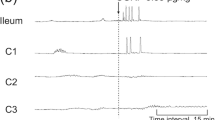Abstract:
Glucagon is commonly used during gastrointestinal examinations for the temporary inhibition of gastroduodenal movements. Three preparations of glucagon are now clinically available: those prepared by extraction from the pancreas (GL-P), by chemical synthesis (GL-S), and by genetic recombination (GL-G). The aim of this study was examine the mechanism of the inhibitory effect of glucagon on gastrointestinal motility and the cause of its side effects by comparing three glucagon preparations. In four conscious dogs, gastrointestinal contractions were monitored by means of chronically implanted force transducers. Each glucagon preparation (GL-P [15 μg/kg], GL-S [5, 15, 45 μg/kg], GL-G [15 μg/kg]), scopolamine butylbromide (0.4 mg/kg), or saline was administered intravenously 20 min after the termination of spontaneous phase III contractions, and blood samples were taken at 5- to 10-min intervals. Barium was administered into the stomach 10 min after the infusion of each drug. The arrival of a barium meal in the stomach immediately stimulated gastrointestinal contractions, and the barium meal was expelled into the duodenum and jejunum from the stomach. Intravenous injection of 15 μg GL-S first stimulated duodenal contractions that propagated to the jejunum, followed by strong inhibition of the barium-induced gastrointestinal contractions. This inhibitory effect of glucagon and the activity of the glucagon-induced duodenal contractions were dose-related. The inhibitory effects of GL-G and GL-S were stronger than that of GL-P. Blood glucose and plasma insulin concentrations were raised after intravenous injection of each glucagon preparation, but there was no difference among the three preparations and no dose relationship. The inhibitory effects of glucagon depend on the material purity and dose, and the inhibitory mechanism was independent of any effect on carbohydrate metabolism. Glucagon administration caused phase III-like contractions in the duodenum and jejunum, which may be responsible for the side effects of glucagon.
Similar content being viewed by others
Author information
Authors and Affiliations
Additional information
(Received Jan. 8, 1998; accepted June 26, 1998)
Rights and permissions
About this article
Cite this article
Mochiki, E., Suzuki, H., Takenoshita, S. et al. Mechanism of inhibitory effect of glucagon on gastrointestinal motility and cause of side effects of glucagon. J Gastroenterol 33, 835–841 (1998). https://doi.org/10.1007/s005350050184
Issue Date:
DOI: https://doi.org/10.1007/s005350050184




